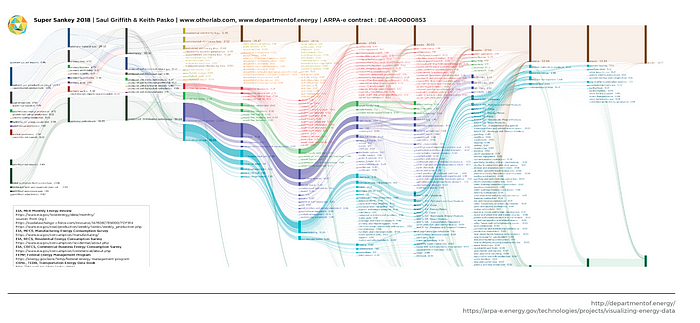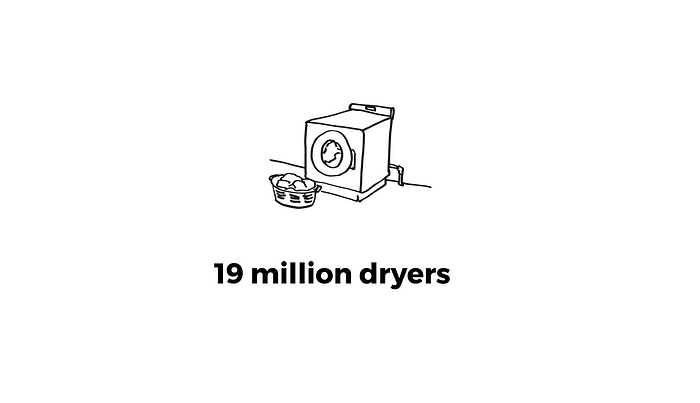One Billion Machines
Decarbonization, demystified

With wildfires in the West, torrential floods in Europe, parched reservoirs, and other dramatic signs that the climate crisis is upon us, we would all like to flip a switch and stop our carbon emissions so that we can save the planet for our children. But in a world full of fossil-fueled machines (and regulations that support them), it’s hard for many people to imagine the pathway to achieving net-zero emissions in time to keep global heating under 1.5–2.0 degrees C above pre-industrial levels. But that pathway can be simply stated: electrify (almost) everything.
It’s time to demystify decarbonization so that we understand what we need to do to switch our economy from one that relies on fossil fuels to one powered by clean electricity. This requires understanding the machines we use, their energy needs, and how, and how quickly, we can transition those machines to ones that are fueled by renewable energy (predominantly wind and solar).
With the goal of identifying the industrial and economic opportunities associated with achieving net-zero emissions for the U.S., it’s useful to start with a list of the demand-side machines that drive our consumption of fossil fuels, and a list of the electrical infrastructure machines that will enable us to provide modern electric alternatives and substitutes. The accounting is based on published data sets — Sankey diagrams the Department of Energy and other agencies created in the 1970s to understand energy usage in light of the oil crisis. The Sankey diagrams show how energy from the supply side (those big fossil fuel producers) flows to the demand side (our cars, dryers, heaters, and other small appliances). We can get granular about where our energy comes from and goes, so we know just how much energy we need to replace to fight the climate crisis.
Want to read this story later? Save it in Heyday.
When we do an accounting of where our energy comes from (supply side) and where it goes (demand side), we can see that in order to decarbonize our economy, we must electrify approximately one billion machines.
Let’s take a look.

Once you’ve mapped the energy flow, you can look at the machines underneath to understand what and how many fossil fuel-burning machines we need to replace with electric machines powered by renewables. With my friend and colleague Sam Calisch, we’ve added up these machines to understand how many we must replace at the earliest opportunity — either at the time of failure or retirement — (we can best achieve our climate goals with a 100 percent adoption rate, which means replacing every fossil-fuel burning machine at the end of its life cycle).

The tally ends up at 1,063,000,000, which is just a little more than a billion machines. That means that 1 billion machines, or 50 million machines a year for the next 20–25 years, is a first-pass approximation at the task to be completed.
On the supply side, that’s a small number of machines that last about 50 years–machines that produce energy, like oil wells (bad!) or wind turbines (good!). On the demand side, that’s a large number of machines that last about 25 years — machines we use in our homes and businesses, like gas-powered trucks, lawnmowers, heaters, and hot tubs (bad!) or their electric equivalents like EVs, heat pumps, and electric-powered appliances backed by solar and wind (good!). It’s about one million large machines and one billion small ones.
This may sound like a lot, but we already have an extraordinary rate of annual machine sales and production. The U.S. manufactures around 12 million automobiles a year, and with imports included, purchases around 17 million. That’s 340 million vehicles in 20 years. Similarly we purchase around 9 million water heaters a year already. The challenge isn’t about making new machines as much as it is about making sure our machines are electric and powered by renewables or nuclear.
Now let’s get a little more granular, and start looking at where our energy comes from, where it goes, and count all the machines along the way. What are those energy sources, where are all those machines and what are they? Once we know, we can electrify them.
Where does our energy go? The sectors

First, let’s look at where our energy goes in the big picture. This Sankey diagram shows energy going from the suppliers into various big categories we call “sectors.’’ The first is “commercial,’’ where we work, which uses 9.5% of US primary energy, but closer to 20% if you count how much energy you lose mining and transporting the coal and natural gas that powers this sector.
The industrial sector, where we make our stuff, uses over 30% of US energy. This is the sector that mines fossil fuels (around 2% of all energy use) and refines oil and natural gas into plastics and fuels (another 4%), so non-fossil energy activity in this industrial sector is much lower.
The transportation sector, which moves us and our stuff around, uses over 30% of US primary energy. Around half goes into our cars and light trucks. Oddly, the diesel used to move coal from mine to generation plant (0.2%) is part of this sector, as is the gas (0.75%) that is used to pump natural gas through hundreds of thousands of miles of pipeline, as well as the 0.5% of US energy flow that goes to aviation fuel for military planes.
The residential sector, where we live, uses 16% of our primary energy (not including the cars in our garage, which are part of the transportation sector). So a lot of our energy use comes from decisions we make at home. (More on that later).
Finally, the electricity sector serves all those other sectors.
When we look at the emissions from all those sectors, we can see that our households account for 42% of the emissions–which means we can solve nearly half of our climate problem from our own households.

From the Sankey diagrams, we see that our household energy use cuts across sectors, adding up to 42% of our energy emissions — from hot water heaters, gas stoves, the cars in our garages, etc. If we focus on replacing those machines as soon as they retire, we will solve nearly half of our carbon emissions problem, buying us time to deal with the big emitters on the supply side and the hard-to-decarbonize sectors of our economy (like long airplane flights).
Where does our fossil-fuel energy come from? (supply-side)
In addition to mapping all those sectors and how much power they use, the Sankey diagrams map the types and amount of fuel that went into those sectors –the barrels of oil, the tons of coal, the millions of cubic feet of natural gas, as well as the nuclear power and renewables (wind, solar, hydro) we use. This is the supply side. On the supply side, a small number of very large machines produce our energy – power plants, mines, wells, refiners, pipelines, and heavy industrial processes. A small number of investment decisions determine how quickly they retire.
Let’s look at our supply-side energy and its machines.
Coal

The US still mines around 730 million tons of coal a year. That’s around 2200kg or 4850lb of coal for every person–enough to fill two large pickup trucks for each of us. 13lb of coal per person, per day, every day. Imagine carrying that home from the grocery store.
Giant coal trucks work at around 669 coal mines in the US. The US has proven reserves of more than 250 billion tons, or more than 300 years of current supply. Those reserves need to remain in the ground, or we have no chance of meeting our climate goals.

Among the largest land vehicles in the world, hundreds of bucket-wheel excavators are used at surface mines across the US, moving hundreds of thousands of tons of material per day.

A few hundred thousand hopper and gondola rail cars are in use moving coal from mine to electricity generation plants. Each carries around 120 tons. As much as a few hundred pounds of coal dust is lost from each car on a 500-mile rail journey.
25,000 diesel locomotives pull our class 1 freight (the category of carriers that earn more than \$250 million in revenue per year), a quarter or more of which is coal.
There are 140,000 miles of freight rail tracks in the US, including right-of-ways. If the typical right–of –ways in the freight rail system were dedicated to industrial solar, the 1.36 million acres would produce approximately 137GW of average year-round power. That’s a lot more than those rails currently deliver in fossil fuels.

241 coal-fired power plants. We burn coal, not very efficiently, in coal plants to make electricity. Coal plants are starting to close due to competition from cheaper natural gas (fracking) and a decrease in the cost of renewable energy. But coal plants remain profitable because the costs of people’s health and the environmental impact of the coal industry (about $.05 per KWh) are not included in the cost of generation.

Oil
We use 7,100,000,000 barrels of oil per year. That’s 300,000,000,000 gallons!

It takes a lot of energy and machines to find, drill, refine, and transport oil. These include:
224,000 miles of pipeline. Nearly a quarter million miles of pipeline connect the oil wells to…
…135 oil refineries. Oil refineries take the crude oil and turn it into gasoline and diesel for our machines.
100,000 tanker trucks take this refined oil to gas stations.

Right now, we have 150,000 gas stations to fuel up our cars, trucks, motorcycles, and other vehicles. Wouldn’t it be great if these were all EV charging stations?
(Not-very-natural) Gas
The US uses nearly 30 trillion cubic feet of natural gas per year. The phrase “natural gas’’ makes it sound like it’s good for the environment. It’s not. It’s a fossil fuel, made up of mostly methane, with varying amounts of other nasty chemicals.
We have 300–500 offshore rigs to pump that gas. Spills from these rigs can pollute ocean waters and harm the species that live in them. Coral reefs are especially sensitive to pollution, and gas releases can kill them. The drilling activity also disrupts marine mammal behavior from sounds and stress.

969,140 gas wells. Nearly a million gas wells are dotted across the landscape, including those that use fracking–horizontal drilling –which has expanded in US, even in residential areas. Fracking affects air, water, and soil quality, and the chemicals released have negative impacts on the health of humans and other species.
321,000 miles of natural gas distribution pipes. We connect those gas wells to over 300,000 miles of gas distribution pipelines. These cause the loss and fragmentation of habitats for many species, change animal movement, and can release methane and carbon emissions when they leak. Gas leaks can pollute groundwater and the soil.
121 liquified natural gas terminals. Natural gas is transported in a liquid state using LNG (liquified natural gas) tankers. LNG terminals are huge facilities for shipping and receiving large amounts of bulk gas, turning the liquified natural gas back into gas and then distributed.

400 underground gas storage facilities. We have over 400 underground gas storage facilities, which are used to iron daily and month variations in usage. Natural gas is commonly stored underground under pressure, usually in depleted reservoirs in oil or natural gas fields, mines, aquifers, and salt cavern formations.
About 2000 gas fired electricity generators. We feed all that natural gas to about 2000 gas-fired generators that make a lot of our electricity– and pollute the air.
1,320,000 miles of gas distribution lines. By putting the gas into over a million gas distribution lines, we get it to all of our homes. The length of all these gas distribution lines would circle the earth 166.7 times.
72 million gas meters. All that gas ends up running through 69 million gas meters in homes, and 3 million meters in commercial buildings. On the other side of that meter are the demand-size machines that use all this fuel.

Where does our fossil-fuel energy go? (demand)
On the other side of our gas meters or the fuel pump at the gas station are our demand-side fossil fuel-burning machines. These are the machines that, along with the supply-side machines, we must replace with ones that burn clean energy. Because nearly half of our emissions come from the machines in our homes and cars in our garages, we can fight climate change by swapping these machines for electric ones when they fail.
Think about this as a pledge: Every time a fossil-fuel burning machine in your home or garage needs to be replaced, strive to replace it with an electric machine backed by renewables. I know, this isn’t possible for everyone for a lot of reasons–mainly financial. At Rewiring America, we’re working on making clean electrification more affordable for everyone. If we can get the upfront costs taken care of, everyone will save on their electric bills.
Now let’s count those demand-side machines.
Road vehicles

We put oil into the 220 million vehicles in our garages (out of 275 million vehicles on the road).
Not every road vehicle will be electrified, but under any full decarbonization scenario the great majority will be. The remainder will be able to operate on biofuels, (renewable) synthetic fuels, and (renewable) hydrogen. There are approximately 17 million automobiles (cars and light trucks) sold in the U.S. each year, of which around 12 million are domestically manufactured. The average age of these vehicles is 11–12 years. These vehicles last around 20–25 years, implying we have one lifecycle to replace them all.

50% are SUVs and crossovers
20% are pickup trucks
5% are minivans
8.5 million are motorcycles
In addition to the vehicles in our garages, we have a lot of commercial vehicles to replace. Some of these will have to be with biofuel for long-haul trucks. We can certainly electrify city and school buses.
These include:
13 million trucks
1 million buses

Household appliances (demand)
On the other side of our gas meters are all of the machines that we use in our homes that we will have to replace when they are retired to meet our climate goals.
Space Heating

There is a large variety of space heating machinery in circulation in the US. These machines include, for example, central furnaces, boilers and gas heaters. 58 million of these heaters use natural gas. 40 million run on electricity. but only about 12% are heat pumps. New heat pump technology can both heat and cool homes much more efficiently, requiring only 1/3 the energy. About 5% of homes use propane, 6% kerosine, and 3% wood for space heating.
Water heating

Of our 117 million water heaters, 56 million of them use gas. Most homes have a tank-type water heater that heats a large volume of water and stores it ready for use. Most of the others are heated by electric resistance or natural gas. There are very viable electric heat-pump driven alternatives now that reduce the energy required by approximately 1/3.
Cooking machines

Cooking is vital to practically all households in the U.S. and is often powered by fossil fuels. Cooking is a cultural touchpoint, and we have been told that high-heat, high-BTU natural gas is the “best.” But excellent electric induction cooking alternatives now exist in every category, as do new cooking appliances such as electric air-fryers. These electric machines improve the air quality (and health) in the house, give greater control over temperature and offer many other advantages for our future kitchens.
Our fossil-fueled cooking machines that must be replaced include:
Clothes machines

We will need to replace 19 million gas clothes dryers for electric ones, which may require (as do many other machines) an upgrade in the breaker box. Don’t forget about solar dryers — hanging them on the line! Washing machines are already all electric, and advances in detergents have enabled much more energy efficient cold water cycles that have substantially reduced US energy use. The only machines using fossil fuels in our laundries are the gas and propane clothes dryers. The most efficient alternatives to these machines are heat-pump electric dryers that use approximately 1/3 of the energy of their resistance electric counterparts.
Not to mention…
In addition to all those machines, we have other gas-powered machines in our homes that add up to 600 million fossil fuel-powered machines:
1.9 million fossil-fueled hot tubs. Just remember that if your hot tub is heated by gas, then you are heating the earth while you’re warming your body.
5 million fossil-fueled pools. Heating pools with fossil fuels is expensive and unnecessary when pool heating is one of the easiest and most cost -effective renewable technologies.
That’s a lot of blue flames.

To get rid of them, we’ll need new household infrastructure

Replacing all those demand-side household machines will mean upgrading electrical breaker boxes to handle the additional electric demand (about three times the previous electric demand). We will also need a lot of machines to enable our electric machines — solar arrays, batteries, chargers.

That all adds up to one billion machines. To meet our carbon goals that means that 500,000 homes need to be cleanly electrified every month for the next 25 years.
The good news is that manufacturing, installing, maintaining, and training people for the new clean economy will require tens of millions of jobs. These are well-paying jobs in every zip code. They’ll be local, because you can’t outsource someone putting solar panels on your roof. Those are not only direct jobs, but the indirect jobs that come when the solar panel installer who has a good salary spends her money on local businesses — the butcher, the baker, the LED-maker.

Saving households money
In addition to creating jobs, the money American households will save on their energy bills will be about $1500–2000 per household per year, provided we get the right rebates and interest rates in place. Rewiring America, with a coalition of nearly 200 organizations, is currently working on passing the Zero-Emissions Home Act of 2021, sponsored by Senator Martin Heinrich (D-NM) and 11 other Senators, to provide some rebates for the up-front costs of clean electrification.

If we can get policies in place to support widespread electrification, scale will bring down the prices of rooftop solar and other clean energy. Throughout the economy we will realize savings of nearly $300 billion dollars per year!
Key is that no household is left behind. These electric purchases need to be the lowest-cost option at every point-of-purchase decision, as soon as possible, in every zip code. You don’t fix the climate unless every household participates and benefits from doing so.

Electrification is the unifying climate solution. The more things we electrify, the easier it is to electrify everything.
War-time effort
In order to electrify everything — in order to take our one shot at saving the climate — we need everyone to participate in an all-out, war-time effort. This will have to be akin to the Arsenal of Democracy, the ramp-up in industrial production that allowed us to save the world from the fascists in World War II. Today the stakes are even higher, because it is all of humanity that is at risk.

We still have one chance to save the planet.
That chance is to electrify everything.
Please join me at rewiringamerica.org.
My new book, Electrify, is out from MIT Press October 12.
With thanks to Sam Calisch and Laura Fraser for their help with data and words, respectively.

Enjoyed this post? Subscribe to the Machine Learnings newsletter for an easy understanding of AI advances shaping our world.
